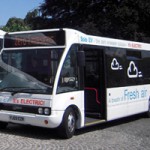The York Council looks set to agree to ban high emission buses and commercial vehicles from the City.
A low emission strategy, first proposed in 2010 should finally get the green light next Tuesday. However, a public consultation exercise conducted earlier in the year attracted responses from fewer than 50 residents.
Sadly the road this strategy has followed has been tortuous and is littered with exaggerated claims and false starts.
A Labour opposition spokesman claimed in 2009 that 158 people died in York because of poor air quality. That seemed unlikely and it emerged last month that this figure was a pro rata extrapolation of a national study which cited “50,000” deaths. The logic applied was that because York has 0.3% of the UK population then it must have the same proportion of air quality deaths!!
In fact no accurate statistical evidence, of the effect that air quality has on local health, currently exists.
Nevertheless, the City now needs to make more progress on improving air quality (a problem in some of our narrow streets, when, in the absence of any wind, levels of NO2 and PMs can reach unacceptable levels). An officer report candidly admits that they don’t actually know why emission levels have been rising recently at some locations. They vaguely blame it on an increase in the number of diesel fuelled vehicles.
It is unfortunate that when Labour took control of the Council in May 2011 they jettisoned some important initiatives.
• A low emission bus trial was taking place on the Fulford corridor http://tinyurl.com/York-eco-bus. This was abandoned as the Council went on an, ultimately fruitless, search for a citywide bus franchise. Relations with York’s largest bus service provider also deteriorated against a background of public recriminations. No low emission buses have yet been ordered for the City (http://tinyurl.com/Low-emission-bus-setback).
• Talks started in 2008 with a taxi operator who was interested in running low emission hybrid cars in the City. With the Council dithering over its priorities for taxi design the opportunity was lost and other Cities have now overtaken York. http://tinyurl.com/York-eco-cabs
• One of the first budget changes made by the new Council was to increase the ResPark badge fees paid by the owners of low emission vehicles. (Ironically they froze the charges for larger vehicles)
• Trials of a new car for the Lord Mayor had been going on for several months. The last Council had decided to evaluate the new Toyota Prius Plus, 7 seater, which was launched in the summer. Unfortunately by then, the new Council had opted for a more expensive vehicle with a 2.4 litre diesel engine. The opportunity to set an example was lost.
• Labour are also pressing ahead with their 20 mph citywide speed limit. This means that most cars will – if they observe the limit – be pushing out higher emissions than they would if they were travelling at 30 mph.
But the main failing of the current approach is the continued unwillingness of the Council to admit how much the transport changes (and particularly the vehicle bans) will cost and what the likely timescale is for it’s implementation. All the report to Tuesdays meeting http://tinyurl.com/emissions-York-9th-Oct-2012 says is that a further report will appear next year.
To support their plan the Council have issued a media statement which includes the following:
“Like other local authorities York has an obligation to meet the Climate Change Act (2008) targets, but has also gone beyond this requirement, setting a number of other challenging climate change reduction targets:
Reducing CO2 emissions across council operations by 25 per cent by 2013
Participation in the national 10:10 campaign to reduce CO2 emissions by 10 per cent in 2010
Signatory to the Friends of the Earth campaign to reduce CO2 emissions by 40 per cent by 2020
Signatory to the European Covenant of Mayors to meet and exceed the European Union (EU) 20 per cent CO2 reduction objective by 2020
York also has to meet challenging targets set for local air pollutants and declare Air Quality Management Areas (AQMAs) where targets are not being met. Local air pollutants are those that have a direct impact on public health, especially that of the young and old, and those with respiratory and circulatory problems.
The main air pollutants of concern in York are nitrogen dioxide (NO2) and particulates (PM). These have been linked to lung diseases (asthma, bronchitis, and emphysema), heart conditions and cancer. The council monitors air quality at over 340 locations in the city and there are currently three AQMAs in York (city centre and Fulford and Salisbury Terrace area).
The city centre Air Quality Management Area boundaries have recently been reviewed, due to deteriorating air quality monitored by the council’s environmental protection unit (EPU).
The new AQMA includes additional buildings in the vicinity of Queen Street. Nitrogen dioxide exceeds the health based targets based upon annual average concentrations.
The objectives of the Low Emission Strategy include:
• Raising public and business awareness and an understanding of emissions to air in order to protect public health and meet the city’s ambition carbon reduction targets
• Assisting bus operators, taxi drivers and other business fleet operators to trial and purchase lower emission and alternatively fuelled vehicles
• Considering a low emission zone (LEZ) to ensure only the cleanest buses, lorries and taxis can enter areas of the city which have poor air quality.”


